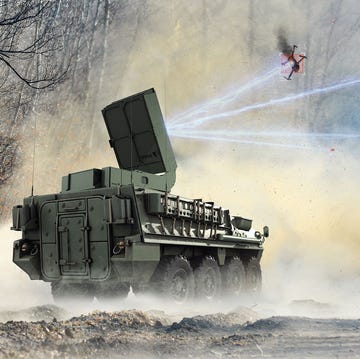- The JLTV is the successor to the Humvee, and the Army plans to buy at least 50,000 in the coming decades.
- The Army, concerned that civilian adoption of electric vehicles could leave it vulnerable, is looking into making the JLTV itself an EV.
- An electric JLTV would reduce the need for diesel fuel at remote outposts, with power provided by solar or nuclear energy.
The U.S. Army could start purchasing electric versions of the Joint Light Tactical Vehicle, the Pentagon’s new replacement for the Humvee. The Army believes that the gradual shift from liquid fuel powered engines to electric engines could force it to electrify its wheeled vehicles. The service cites both logistical but also economic reasons why a JLTV-EV might be in its future.
The JLTV is an armored 4x4 utility vehicle designed to offer increased crew protection than the older Humvee. The spiritual successor to the World War II era jeep, the Army plans to buy three variants: a general purpose flatbed variant, heavy guns carrier variant, and close combat weapon carrier variant. JLTV is large and features a Banks 866T turbo diesel engine, itself based on the Duramax 6.6-liter V-8 diesel. From a logistical standpoint, however, one of the JLTV’s best features may in fact make it vulnerable in the long run.
The Army, Military.com reports, is concerned that the shift towards electrification in the civilian sector could force them to electrify the JLTV. As electric vehicles grow more popular the cost of internal combustion systems—and perhaps fuel prices—will go up. The U.S. Army plans to eventually purchase a large fleet of 49,099 JLTVs, vehicles that will serve for 20 years or more, and an unexpected increase in costs would impact the service’s bottom line.
There are also operational reasons why the Army might abandon internal combustion. Fuel must be manufactured at refineries and then shipped to the front line, often traversing dangerous territory to reach the troops that depend on it. Supply convoys in Iraq and Afghanistan, for example, were forced to navigate dangerous roads infested with improvised explosive devices and guerrilla ambushes. Hundreds of military truck drivers were killed or wounded.
Electric vehicles, on the other hand, could be resupplied a number of ways. Smaller fleets could receive power by the sun, while larger fleets at sprawling megabases could draw power from a new generation of portable military nuclear reactors. Achieving energy self-sufficiency would go a long way towards reducing the logistical “tail” of U.S. combat forces.
An electric JLTV would also have some tactical advantage on the battlefield. Electric vehicles are considerably quieter than internal combustion vehicles, particularly diesel vehicles, which would make them more difficult to detect on the battlefield. This could make the JLTV an effective “sneak and peak” reconnaissance vehicle, able to sneak up to enemy front lines and quietly observe without being detected.
Source: Military.com

Kyle Mizokami is a writer on defense and security issues and has been at Popular Mechanics since 2015. If it involves explosions or projectiles, he's generally in favor of it. Kyle’s articles have appeared at The Daily Beast, U.S. Naval Institute News, The Diplomat, Foreign Policy, Combat Aircraft Monthly, VICE News, and others. He lives in San Francisco.














